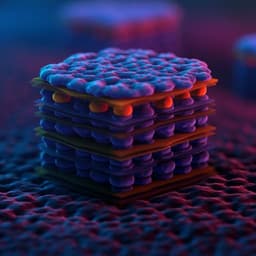
Physics
Electron correlation effects on exchange interactions and spin excitations in 2D van der Waals materials
L. Ke and M. I. Katsnelson
This groundbreaking research conducted by Liqin Ke and Mikhail I. Katsnelson delves into the magnetic interactions and electron-correlation effects in 2D van der Waals materials, revealing intriguing insights about CrI₃. The study uncovers a correlation-enhanced interlayer interaction leading to a magnon gap, offering a fresh perspective that challenges existing theories.
~3 min • Beginner • English
Introduction
Correlated electrons, lattice, and magnetism in 2D materials with open d- or f-shells can produce rich phenomena. Reduced dimensionality suppresses screening and enhances electron correlation, particularly in magnetic 2D van der Waals (vdW) materials, whose magnetism is highly tunable by pressure, stacking, and external fields. Even in bulk, quasi-2D lattices reduce coordination and hopping, enhancing Coulomb interactions and directly affecting exchange interactions. A key question is how magnetic excitations in these confined systems can be understood, controlled, and exploited. Despite attention, accurate ab initio descriptions of spin excitations and magnetic interactions in magnetic 2D vdW materials are lacking, complicated by spin-orbit coupling (SOC) effects. In 2D honeycomb ferromagnets (magnetic analogs of graphene), introducing next-nearest-neighbor Dzyaloshinskii-Moriya interaction (DMI) can open a spin-wave (SW) gap at Dirac points, allowing topological magnons. INS experiments reported a gap along high-symmetry lines in pristine CrI₃, implying sizable DMI or Kitaev interactions; however, ab initio studies indicate both DMI and Kitaev interactions are insufficient to account for the experimental gap. Irrespective of SOC, exchange interactions need to be reexamined beyond DFT to address electron-correlation effects. In this work, using CrI₃, we identify the role of electron correlations on magnetic interactions and excitations by computing the dynamic transverse spin susceptibility (DTSS) and comparing with INS. Correlation effects beyond DFT are included via quasiparticle self-consistent GW (QSGW), with explicit on-site and off-site nonlocal potentials. We show explicit treatment of correlations is required, especially for interlayer interactions, and discover a magnon gap along Γ-K-M arising from correlation-enhanced interlayer Cr–I–I–Cr super-superexchange, even without relativistic exchanges.
Literature Review
Prior theoretical work showed that DMI on a 2D honeycomb ferromagnet can open a SW gap at Dirac points, enabling topological magnons. INS measurements on CrI₃ observed a gap along high-symmetry lines, previously attributed to DMI or Kitaev interactions. However, ab initio investigations reported that DMI and Kitaev terms in pristine CrI₃ are too small to explain the observed gap. Most theoretical treatments of magnetic interactions in m2Dv have used energy-mapping of total energies (often with DFT+U) into a Heisenberg model; DFT overestimates exchange couplings by ~50%, and adding U often worsens agreement. Magnetic force theorem (MFT) studies can be more suitable for small spin deviations and allow orbital resolution, but reported values vary and even show opposite U trends, likely due to details of tight-binding Hamiltonian and Green’s function constructions (often Wannier-based). Computing DTSS is challenging beyond mean-field, including enforcing the Goldstone mode. Prior work has been largely limited to simpler systems. Overall, the literature indicates unresolved roles of SOC and electron correlations in CrI₃’s spin excitations and gaps, motivating approaches beyond DFT with explicit nonlocal correlations.
Methodology
- Electronic structure methods: Used quasiparticle self-consistent GW (QSGW) to include explicit on-site and long-range off-site nonlocal potentials beyond DFT. For comparison, DFT+U was also employed to mimic on-site Hubbard corrections on Cr-d states. In some cases, QSGW was applied on top of DFT+U (QSGW+U) to account for additional on-site interactions.
- Linear response DTSS: Starting from a self-consistent ab initio band structure, computed the bare transverse spin susceptibility χ₀(r, r′, q, ω) via linear response and the full susceptibility χ within the random phase approximation (RPA), χ = χ₀ + χ₀Iχ, with the exchange-correlation kernel I determined from a sum rule to satisfy the Goldstone theorem (spin wave at q=0, ω=0 in absence of SOC).
- Projection/discretization: Because moments/excitations are localized on Cr sites, χ₀ was computed on a product basis and projected onto local spin densities of Cr pairs, discretizing χ₀(r, r′, q, ω) into χ₀(i, j, q, ω), where i, j label Cr sites. This enables (1) determining I via sum rule; (2) mapping to a Heisenberg model to extract pairwise exchanges; and (3) reducing computational cost.
- Spin-wave (SW) spectra: Calculated Im[χ₀(q, ω)] (Stoner excitations) and Im[χ(q, ω)] (collective SW) along high-symmetry paths. High-resolution spectra near Dirac points were obtained by computing real-space χ₀(R, ω) on an R-mesh and Fourier transforming to χ₀(q, ω) on dense q-paths.
- Structures and symmetry: Considered rhombohedral low-T R-CrI₃ (FM) and monoclinic high-T M-CrI₃ (A-type AFM). Interlayer couplings were treated explicitly in the rhombohedral symmetry rather than a single effective parameter, given sensitivity to stacking and super-superexchange paths.
- Exchange parameter extraction: Within the adiabatic approximation, mapped χ to a classical Heisenberg model H = −Σ₍ij₎ Jᵢⱼ êᵢ·êⱼ. Effective pair exchanges were computed from matrix elements of [χ(q, ω=0)]⁻¹ projected onto normalized local spin densities, followed by Fourier transform to real-space J(R). An 8×8×8 q-mesh was used (12×12×12 gave negligible changes to SW). Exchanges beyond ~12 Å are negligible.
- Linear SW theory: Using Holstein–Primakoff transformation, SW energies of acoustic/optical modes are E(q) = [A(0)+B(0)−A(q) ± |B(q)|]/2, with A(q), B(q) sums of J(q) over intra- and inter-sublattice pairs, respectively. Along Γ-K-M, J₁(q), J₃(q), J₁⁺(q) are real and vanish at K, J₀(q) is a real constant for in-plane q, and J₂-like terms can be complex, influencing gaps.
- SOC treatment: DTSS and SW spectra were computed without SOC to isolate correlation effects; Goldstone mode enforced via sum rule on I.
Key Findings
- DFT vs experiment: DFT places Stoner excitations at ~1.7–3 eV, well above SW energies (no damping), supporting a localized-spin Heisenberg mapping. DFT overestimates the optical SW maximum (~30 meV vs ~20 meV in INS) by ~50% and severely overestimates the acoustic branch, especially along the interlayer (z) direction (by ~4× at Z).
- DFT+U (U=3 eV): Lowers both branches; Z-point energy reduces to ~5.8 meV (about 2/3 of DFT) but remains ~3× larger than INS. Optical branch becomes too flat relative to experiment. A gap appears at the Dirac point along Γ-K-M even without SOC.
- QSGW: Optical magnon centered ~24 meV (closer to INS) and recovers dispersion. Acoustic energies are reduced relative to DFT+U; Z-point energy drops to ~3.4 meV, indicating substantially weaker interlayer FM coupling and better overall agreement with INS.
- QSGW+U (U=1.36 eV): Further improves agreement; in-plane acoustic SW still somewhat high, but overall spectra match INS well. The correlation-induced gap along Γ-K-M is ~1.8 meV (experiment ~4 meV).
- Exchange parameters: Nonlocal correlations (QSGW) significantly reduce longer-range interlayer couplings, while DFT+U more strongly reduces nearest-neighbor J₁. Compared to DFT, DFT+U lowers J₁ by ~19% and overall interlayer FM couplings J⊥ by ~27%; QSGW lowers J₁ by ~14% and interlayer couplings by ~60% (values consistent with Table 1 trends). Exchanges beyond ~12 Å are negligible.
- Correlation-enhanced interlayer super-superexchange: Identified a previously unreported AFM interlayer J₂ (Cr–I–I–Cr path; ~159° Cr–I–I angle) that is negligible in DFT but becomes sizable in QSGW/DFT+U, reaching J₂ ≈ 10%·J₁ in QSGW+U. The symmetry-inequivalent counterpart J₂₀ vanishes. The nonequivalence (J₂ ≠ J₂₀) yields a finite complex B(q) and opens a magnon gap along Γ-K-M without SOC, rotating Dirac nodal lines off the high-symmetry plane.
- Dirac nodal lines: With QSGW+U-derived J’s, helical Dirac nodal lines wind around K along k_z; they do not intersect the Γ-K-M line (k_z=0 plane). Predicted small displacement of Dirac points off Γ-K.
- Stacking dependence: In monoclinic M-CrI₃, QSGW SW spectra indicate FM interlayer configuration is unstable (negative SW energies along Γ–Z), while A-type AFM configuration is stable (positive SW throughout BZ), correctly capturing stacking-dependent interlayer magnetism in a parameter-free manner.
- Methodological insight: Linear-response-derived exchanges decrease with added correlations and better match SW spectra, while energy-mapping with multiple collinear states shows the opposite U-trend, suggesting important non-Heisenberg interactions (e.g., biquadratic, multi-site) possibly mediated by iodine ligand polarization.
Discussion
The study addresses how electron correlations govern magnetic interactions and spin excitations in 2D vdW magnets using CrI₃. By explicitly including nonlocal correlations via QSGW (and modest on-site corrections), the calculated SW spectra align closely with INS, resolving the DFT overestimation of exchange and interlayer couplings. Crucially, the observed magnon gap along Γ-K-M can arise without relativistic interactions: a correlation-enhanced, symmetry-inequivalent interlayer super-superexchange J₂ (Cr–I–I–Cr) generates a finite B(q) and opens the gap, providing an alternative to prior DMI/Kitaev explanations. This mechanism also predicts Dirac nodal lines displaced off high-symmetry lines, a testable signature. The contrast between linear-response and energy-mapping trends with U highlights non-Heisenberg contributions and the importance of ligand polarization. Finally, QSGW captures stacking-dependent interlayer magnetism (FM in rhombohedral vs A-type AFM in monoclinic), underscoring the critical role of explicit correlations for accurate, parameter-free descriptions of spin ordering and dynamics in layered magnets.
Conclusion
An ab initio treatment of nonlocal electron correlations beyond DFT is essential to accurately describe exchange interactions and spin excitations in CrI₃ and related 2D vdW magnets. QSGW (and QSGW+U) improves agreement with INS, substantially correcting both in-plane and interlayer SW energies. The work uncovers a correlation-enhanced, symmetry-inequivalent interlayer Cr–I–I–Cr super-superexchange (J₂) that opens a magnon gap along Γ-K-M without SOC, offering a new perspective on gap formation previously attributed to DMI/Kitaev or magnon–phonon coupling. The approach also correctly predicts stacking-dependent interlayer magnetism in monoclinic CrI₃. Future research should (i) experimentally probe off–Γ-K Dirac crossings via high-resolution INS, (ii) examine monolayer CrI₃ (e.g., by electron energy loss spectroscopy) to isolate interlayer effects, and (iii) develop more comprehensive many-body frameworks (e.g., QSGW+DMFT) to capture both nonlocal and dynamic correlations and potential non-Heisenberg interactions.
Limitations
- SOC not included in DTSS calculations; while intentional to isolate correlation effects, SOC could contribute to the observed experimental gap and anisotropies.
- The correlation-induced magnon gap (~1.8 meV in QSGW+U) is smaller than the ~4 meV reported by INS, suggesting additional interactions (SOC, magnon–phonon coupling, or stronger on-site correlations) may be needed.
- GW methods may underestimate on-site interactions; QSGW+U is an approximate remedy. A more rigorous treatment (e.g., QSGW+DMFT) is suggested but not implemented.
- Linear-response Heisenberg mapping assumes rigid spins and neglects possible non-Heisenberg terms (biquadratic, multi-site), which could be significant due to ligand polarization.
- Experimental verification of off–high-symmetry Dirac nodal lines requires high-resolution INS and excellent samples; single-layer INS is challenging, limiting direct validation of interlayer effects.
Related Publications
Explore these studies to deepen your understanding of the subject.







